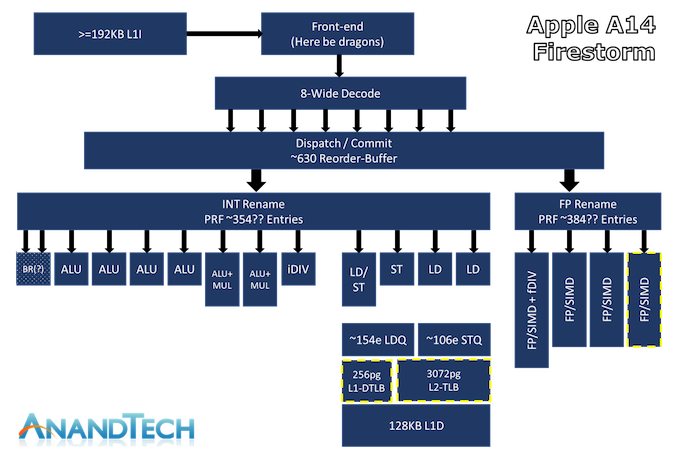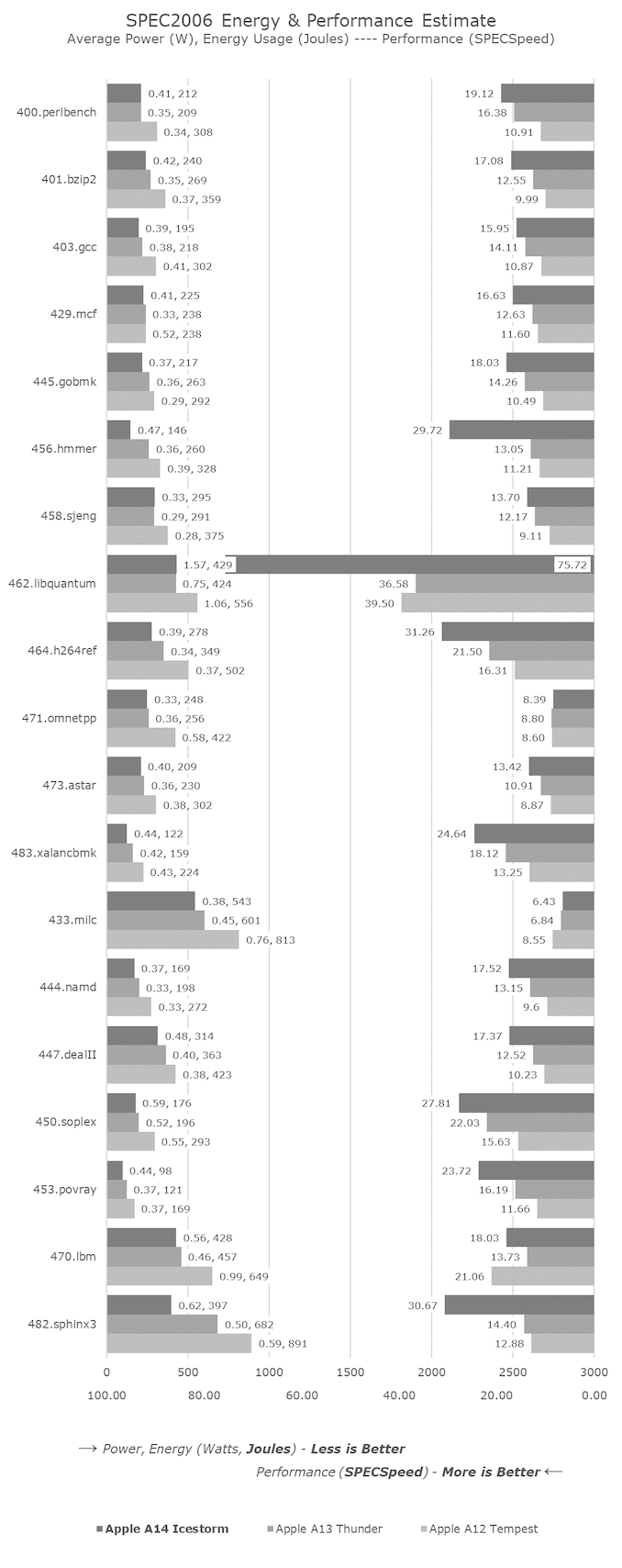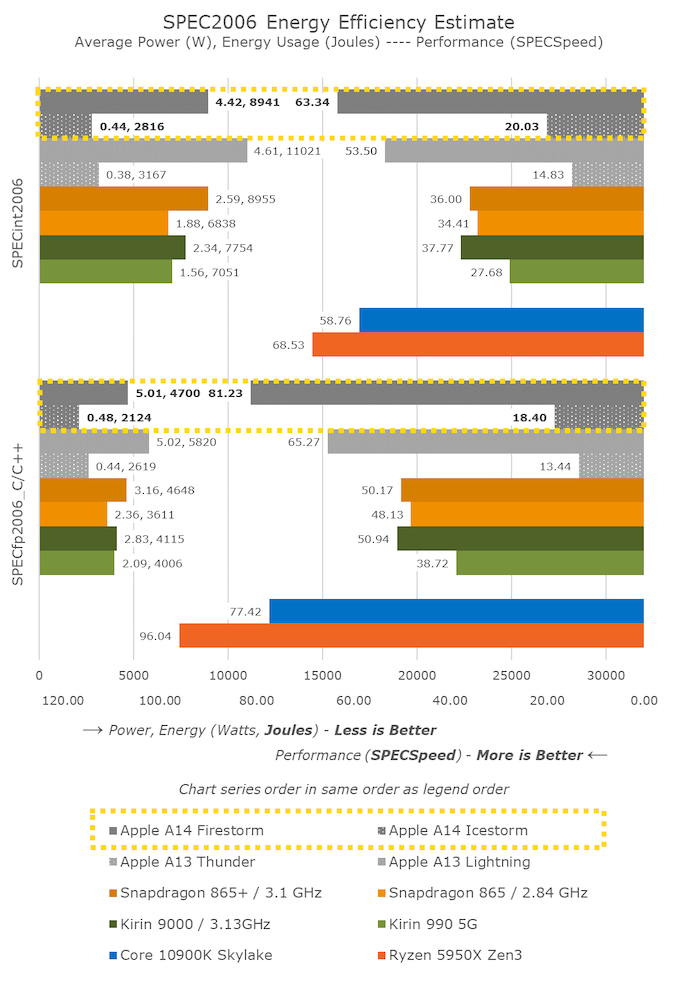The iPhone 12 & 12 Pro Review: New Design and Diminishing Returns
by Andrei Frumusanu on November 30, 2020 8:30 AM EST- Posted in
- Mobile
- Apple
- Smartphones
- Apple A14
- iPhone 12
- iPhone 12 Pro
The Apple A14 SoC: Firestorm & Icestorm
The new Apple A14 is the company’s newest mobile SoC and sits at the heart of the new iPhone 12 series. The new chip is the industry’s first commercial 5nm manufactured chip from TSMC, alongside the now no longer manufactured Kirin 9000.
Inside the A14 we find two big performance cores dubbed “Firestorm” and four efficiency cores called “Icestorm”, making this a 2+4 heterogeneous CPU SoC. Alongside the CPUs, we also find a 4-core GPU. Unfortunately this year it seems like we haven’t seen a public die shot of the A14, though Apple themselves published a shot of the M1 during their announcement event.
| Maximum Frequency vs Loaded Threads Per-Core Maximum MHz |
||||||
| Apple A13 | 1 | 2 | 3 | 4 | 5 | 6 |
| Performance 1 | 2666 | 2590 | 2590 | 2590 | 2590 | 2590 |
| Performance 2 | 2590 | 2590 | 2590 | 2590 | 2590 | |
| Efficiency 1 | 1728 | 1728 | 1728 | 1728 | ||
| Efficiency 2 | 1728 | 1728 | 1728 | |||
| Efficiency 3 | 1728 | 1728 | ||||
| Efficiency 4 | 1728 | |||||
| Apple A14 | 1 | 2 | 3 | 4 | 5 | 6 |
| Performance 1 | 2998 | 2890 | 2890 | 2890 | 2890 | 2890 |
| Performance 2 | 2890 | 2890 | 2890 | 2890 | 2890 | |
| Efficiency 1 | 1823 | 1823 | 1823 | 1823 | ||
| Efficiency 2 | 1823 | 1823 | 1823 | |||
| Efficiency 3 | 1823 | 1823 | ||||
| Efficiency 4 | 1823 | |||||
The new A14 raises the clock speeds of the CPU by a good amount, now essentially reaching 3GHz on the large performance cores in single-threaded scenarios. Once a second big cores come on this reduces to 2.89GHz and stays there even in heavier multi-threaded workloads. The efficiency cores land in at 1823MHz now, roughly a 100MHz boost over the A13, but we do know that in power unconstrained scenarios they can reach quite higher, such as 2064MHz employed on the M1.
The summary is that in this generation, Apple progresses the design further and making it wider than before, increasing the ROB size from 560 to 630, having significantly larger L1 DTLB which has now doubled in size from 128 pages to 256 pages, and increasing the L2 TLB from 2048 pages to 3072 pages. It’s particularly on the part of the floating point and vector execution units where the new Firestorm cores saw most of the design changes this year through the introduction of a 4th pipeline unit, essentially increasing the execution capabilities of this part of the design by 33%. On the integer side of the CPU, things have remained relatively the same with only minor changes, and the Firestorm cores continue on with the sale 192KB L1 I-cache and 128 L1 D-cache and 8MB of shared L2 amongst the two cores.
What we didn’t cover in more detail in the M1 piece was the new small efficiency cores. The Icestorm design is actually a quite major leap for Apple as it sees the introduction of a third integer ALU pipeline, and a full second FP/SIMD pipeline, vastly increasing the execution capabilities of this core. At this point it would be wrong to call it a “small” core anymore as it now essentially matches the big core designs from Arm from a few years ago, being similar in complexity as an A75.
Looking at the generational improvements of the efficiency cores we can see that Apple is indeed showcasing performance increases beyond that of just the increased 100MHz of the cores, with substantial upgrades across the workload spectrum.
Especially the floating-point workloads of the SPEC suite see very large improvements, exactly in the tests which are more execution heavy such as 453.povray or 482.sphinx3.
Apple still continues to limit the absolute performance of the efficiency cores when they are the only allowing the memory controller to not scale up to a higher frequency, meaning that the scores here in isolation are posting worse performance than in a normal more varied real-world scenario where the big CPU cores or the GPU would also be active, hence the scores aren’t directly comparable to other measurements we’ve made.
Overall, the new A14 is massively impressive and grows the performance gap compared to the competition. Apple has now reached higher single-threaded performance within their phone SoCs than what Intel can deliver in any of their designs, whilst only losing out to the desktop variants of AMD’s new Zen3 processors.
What’s important to note here is that Apple’s performance increase this generation did not come at a cost of increased power consumption, as the designers were able to leverage the microarchitectural improvements and the new process node – actually reaching either power parity or a small power reduction compared to the 7nm based A13. This means that the performance increases this generation also results in an energy efficiency increase for the design, with the A14 using notably less energy to complete a workload.
I’ve included the efficiency cores in the chart here to showcase that they’re not weak at all. The performance showcased here roughly matches a 2.2GHz Cortex-A76 which is essentially 4x faster than the performance of any other mobile SoC today which relies on Cortex-A55 cores, all while using roughly the same amount of system power and having 3x the power efficiency.













101 Comments
View All Comments
PickUrPoison - Saturday, December 12, 2020 - link
5s and 6 are like $25-50 used, they’re 5+ years old.TelstarTOS - Monday, November 30, 2020 - link
yet another skip year with notch.PickUrPoison - Saturday, December 12, 2020 - link
Get used to it. Apple’s ok with it. Eventually it’ll get smaller and occupy minimal bezel space. Think 7-10 years and be happy if it’s faster.anonomouse - Monday, November 30, 2020 - link
Is there a pending Mate 40 Pro / Kirin 9000 review where all of the numbers for that are coming from? The GPU in particular for that looks very.... not great.tk.icepick - Monday, November 30, 2020 - link
Great review Andrei!A small error: On the GPU Performance & Power page, the performance drop from 11 Pro to 12 Pro is 64.78 fps to 56.06 fps. The following paragraph lists a 45% performance regression, but that would be comparing the peak performance of 11 Pro to the sustained performance of 12 Pro.
56.06/64.78 = 86.53%. Still a regression, but only ~14%, not 45.
dudedud - Monday, November 30, 2020 - link
Speaking of the throttling, do the 12 series employ the same graphene layer to disperse the heat as last year iPhones?I haven't seen any indication of using it this time (iFixit didn't mention it), and maybe that's the reason for the lower sustained performance even when the efficiency is better?
flyingpants265 - Monday, November 30, 2020 - link
$799 is high, but it's more reasonable than $1300.Always remember that the Realme X 4GB is $145 USD on AliExpress, that should be the price for all budget phones going forward.
Amandtec - Tuesday, December 1, 2020 - link
Unless you work in an industry where China engages in industrial espionage. Then the extra $600 is easily worth it.flyingpants265 - Tuesday, December 1, 2020 - link
No, that doesn't matter at all. The point is that phones are cheap to make, and we should seek an option between $145-300 USD. Not an artificially gimped or overpriced option, or "midrange plus" Samsung phones sold to clueless consumers for $600 or more with inferior specifications. $300 is a good price for a Nexus 5 type phone.FunBunny2 - Tuesday, December 1, 2020 - link
"The point is that phones are cheap to make"depends on why that is.
1 - they're still made with a high level of labor input (not so much automation), both the final assembly that most consider 'making the phone' and the same for all the constituent parts all the way down the BoM
2 - they're made with a high level of automation (not so much labor), ditto the rest
in the 1) case, all producers from final assembly down the BoM, can maintain minimum average cost for most levels of output simply by expanding or contracting the labor force, and thus preserve profit
in the 2) case, there's less flexibility to maintain minimum average cost at any level of output, since all that automation has to be paid for no matter the level of output. in fact, the only way to maximize profit is to run that automation 24/7/365, thus spreading capital cost as thinly as possible over maximum output. moving production to still more 'business friendly, labor antagonistic' jurisdictions means there's less and less money to be had by exploiting labor; just not enough in the BoM to exploit.
so, if the BoM for smartphones is closer to 2), it's in the companies interest to maximize output level at all times, thus increasing supply, thus competition for consumers, and thus a lowering of actual sale price.
perhaps one of the AT mavens could look into this?